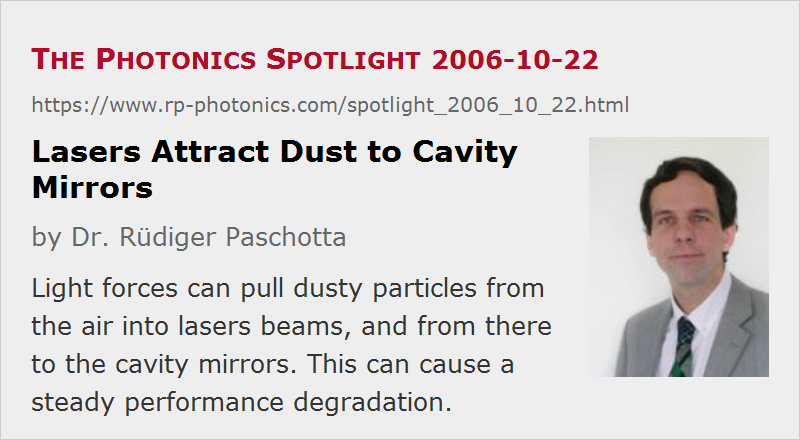Lasers Attract Dust to Cavity Mirrors
Posted on 2006-10-22 as a part of the Photonics Spotlight (available as e-mail newsletter!)
Permanent link: https://www.rp-photonics.com/spotlight_2006_10_22.html
Author: Dr. Rüdiger Paschotta, RP Photonics Consulting GmbH
Abstract: Light forces can pull dusty particles from the air into lasers beams, and from there to the cavity mirrors. This can cause a steady performance degradation.

At least in visible laser beams, one can often easily observe dust particles captured in the beam focus. They are dancing around, and cannot escape from the focus as long as no air current blows them away. A few hundred milliwatts e.g. in a green laser beam are sufficient. The effect results from light forces on the dust particles, creating a sufficiently deep potential, combined with friction in air, which dissipates the excess energy. The particles experience a dipole force toward the regions with highest optical intensity, i.e. not only toward the beam axis, but also toward the beam waist, even though the gradient in that direction is normally much smaller, so that it can take a while to get there.
The less than funny aspect of this phenomenon is of course that this effect can systematically push dust particles to cavity mirrors and capture them there until they are burned in. This leads to a steady performance degradation or even failure of the laser. Note that the effect also occurs in infrared lasers, even though it may not be as obvious there.
The best solution is of course to have the laser setup in an air-tight enclosure, and to do the assembly and any maintenance (with opened enclosure) in a clean room, or at least below a flow box. Particularly for maintenance, this can of course be hard to arrange, if the laser is operated in a not very clean environment.
This article is a posting of the Photonics Spotlight, authored by Dr. Rüdiger Paschotta. You may link to this page and cite it, because its location is permanent. See also the RP Photonics Encyclopedia.
Note that you can also receive the articles in the form of a newsletter or with an RSS feed.
Questions and Comments from Users
Here you can submit questions and comments. As far as they get accepted by the author, they will appear above this paragraph together with the author’s answer. The author will decide on acceptance based on certain criteria. Essentially, the issue must be of sufficiently broad interest.
Please do not enter personal data here; we would otherwise delete it soon. (See also our privacy declaration.) If you wish to receive personal feedback or consultancy from the author, please contact him e.g. via e-mail.
By submitting the information, you give your consent to the potential publication of your inputs on our website according to our rules. (If you later retract your consent, we will delete those inputs.) As your inputs are first reviewed by the author, they may be published with some delay.
 |



If you like this page, please share the link with your friends and colleagues, e.g. via social media:
These sharing buttons are implemented in a privacy-friendly way!